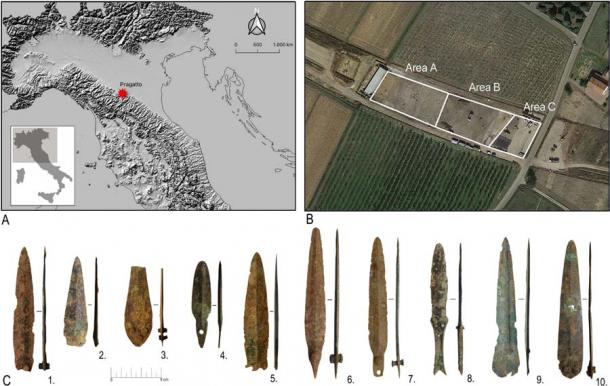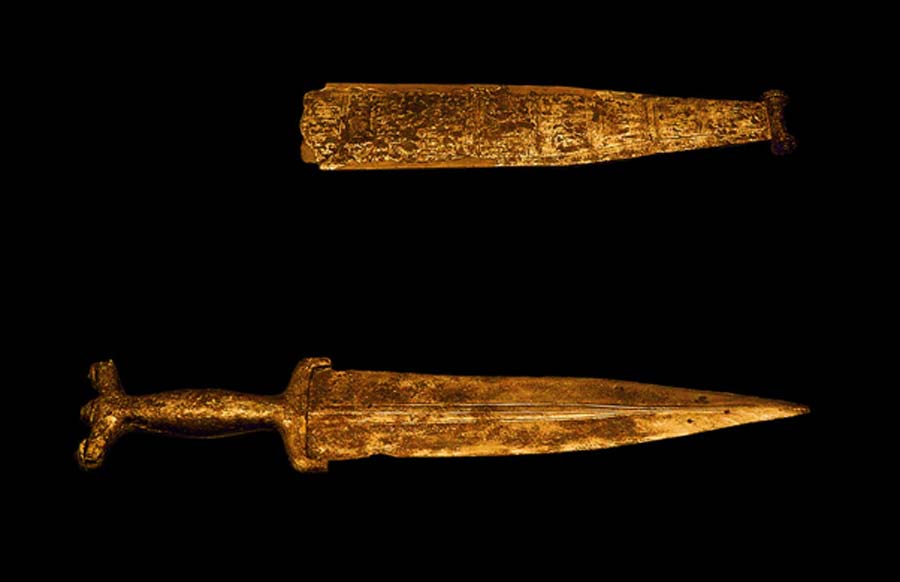Bronze Age Daggers Were Tools to Butcher Animals, Not Markers of Status
Excavations of Bronze Age “warrior graves” throughout Europe have nearly always led to the recovery of copper alloy Bronze Age daggers. However, their function has been poorly understood. It has long been speculated that they, in fact, didn’t serve any practical purpose and were symbols of status and identity. Now, a new study published in the journal Scientific Reports has suggested that they served a functional purpose and were used to butcher and carve animal carcasses.
Bronze Age Daggers: Symbolic or Functional?
Daggers first made their appearance in prehistoric Europe in the fourth millennium BC. They were made of either flint or copper alloy depending on the availability of raw material. From the second millennium BC, flint daggers had been almost entirely overwhelmed by copper-alloy Bronze Age daggers.
With an almost ubiquitous presence in male burials or “warrior graves” that were plentifully furnished with weapons, some archaeologists have argued that Bronze Age daggers lacked any functional purpose and were simply markers of identity and status. This non-functionality has been attributed to them because copper alloys are weak metals. Moreover, the daggers were thought to have design flaws that inhibited any practical use. However, other archaeologists have suggested that they were used as weapons or craft tools, reports a Newcastle University press release.
- The Bronze Age - A Spark That Changed the World
- Metal Detectorist Milly Hardwick Finds Bronze Age Hoard of Axe Heads

The Bronze Age daggers analyzed in the recent study were all from the same area in Italy (A; the map was generated by I.C. through QGIS v.3.16, https://qgis.org); (B) An aerial view of the site highlighting excavation areas A, B and C (source: Google Earth); (C) Copper-alloy daggers analyzed as part of the research. (Scientific Reports)
While archaeologists have used a variety of chemical tests to analyze ceramic, stone and shell artifacts, no specific test had hitherto been developed for copper-alloy metals, according to the recent study. And so, the debate around the use of prehistoric Bronze Age daggers made of these alloys has always been speculative.
That was, until now. An international research team, led by Newcastle University in the UK, devised a revolutionary new non-destructive technique for extracting organic residues from copper-alloy metals.
New Tech Finds Animal Residues On Bronze Age Daggers!
The team selected and analyzed 10 daggers recovered in 2017 from Pragatto, a Bronze Age site in Italy. The new analysis “enabled the world's first extraction of organic residues,” which revealed “for the first time, how these objects were used, for what tasks, and on what materials,” said the research team in the Newcastle University press release.
The project team, led by Dr Andrea Dolfini and Isabella Caricola, used a type of diagnostic dye solution called Picro-Sirius Red (PSR) to stain the dagger blades. The daggers were then examined under optical, digital and scanning electron microscopes to determine if there were any residues and if they were organic.
The Bronze Age daggers’ PSR test results indicated micro traces of type I and type II collagen protein, bone, muscle, and bundle tendon fibers from numerous animals. The presence of this residue indicates that the knives were often in contact with animal carcasses and were used to slaughter animals, butcher the carcasses, and carve meat from the bone.
The results were then verified through a microwear analysis (a method used to record wear traces on artifacts) on butchered animal bones from other Bronze Age sites that exhibit metal cut marks on them.
The team also experimented with replica daggers and knives made by a contemporary bronzesmith. These replicas were then used for the functions the researchers are attributing to the Bronze Age daggers. The residues were then compared with those on the prehistoric daggers and were found to match.
Professor Andrea Dolfini, Chair of Archaeology, Newcastle University, said:
“The research has revealed that it is possible to extract and characterize organic residues from ancient metals, extending the range of materials that can be analyzed in this way. This is a significant breakthrough as the new method enables the analysis of a wide variety of copper-alloy tools and weapons from anywhere in the world. The possibilities are endless, and so are the answers that the new method can and will provide in the future.”
- The Copper Age: When Metallurgy Came to Rule the World
- Rare Bronze Age Spearhead has Remained Intact for Thousands of Years!
The study has shown that Bronze Age daggers were not simply symbolic markers of male identity and power but were used as meat butchering tools and in battle as weapons. The new PSR technique has great possibilities as it can be applied to any copper-alloy artifacts to find out how they were used and why.
Top image: Bronze Age daggers, like this one found near Lake Neuchâtel, Switzerland, were always assumed to be ceremonial status weapons, but a recent study has shown that they were actually used a lot to butcher animals! Source: Rama / CC BY-SA 3.0 FR
By Sahir Pandey
References
Carcicola, I. et al. 2022. Organic residue analysis reveals the function of bronze age metal daggers. Scientific Reports. Available at: https://www.nature.com/articles/s41598-022-09983-3
McKelvie, C. 2022. Bronze Age 'grave daggers' were actually used to butcher animals. Available at: https://www.livescience.com/bronze-age-daggers
Newcastle University Press Office, 2022. Research finally answers what Bronze Age daggers were used for. Available at: https://www.ncl.ac.uk/press/articles/latest/2022/04/bronzeagedaggers/


















Comments
I find it very hard to interpret a dagger as a butchers tool.
I am certain that a knife blade for a butcher would be of a different shape and have a different handle. Surely a dagger is a stabbing tool.
Without tyrants, there is no need for weaponry. But the tyrants came, with weapons, and the villagers had to respond in kind. But when did it start?
Nobody gets paid to tell the truth.